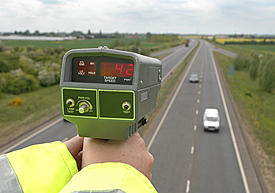
Police officer uses a handheld down-the-road (DTR) radar.
While today's law enforcement officers don't wear utility belts full of crimefighting gadgets like Batman, they do rely on a variety of state-of-the-art technologies to do their jobs efficiently and safely. Two of these devices—down-the-road (DTR) radar used in speed enforcement and the ballistic chronograph, which measures the speed of bullets—soon should be more useful tools thanks to recent research conducted by the Office of Law Enforcement Standards (OLES) at the National Institute of Standards and Technology (NIST).
In a forthcoming paper in The Journal of Research of the National Institute of Standards and Technology,* researchers John Jendzurski and Nicholas Paulter examined the four methods commonly used by law enforcement officers to calibrate DTR radar devices and, for each one, determined the uncertainty it places on the measurement of a moving target. The calibration methods studied included a radar target simulator (an audio frequency source best used in a test facility and designed to mimic various speeds of a moving object), tuning forks (provide a range of audio frequencies that simulate different vehicle speeds and are easily used in the field), a calibrated speedometer (where the DTR measurement is dependent on accuracy of the test car's speedometer) and a fifth wheel (using the measured speed of a wheel attached to the rear of the test vehicle instead of relying on the car's speedometer).
Based on the data they obtained, the researchers developed and published uncertainty measurement formulas for each calibration method. These formulas will help DTR radar users clearly understand the impact of proper calibration for making accurate speed measurements.
In the second OLES publication, a paper in the April 2009 issue of Optical Engineering,** researchers Donald Larson and Nicholas Paulter developed a ballistic chronograph—an instrument used to measure of the velocity of a fired bullet—that is 20 times more precise than a typical manufacturer-provided chronograph. The new instrument has an uncertainty of only ± 0.2 meters per second compared to ± 4 meters per second for a bullet travelling 400 meters per second. The NIST chronograph may be used as a reference standard to calibrate and/or characterize the performance of chronographs available on the market. Law enforcement agencies and the military use chronographs during the testing of ballistic resistant body armors (commonly, but inaccurately, known as "bulletproof vests") because their effectiveness is determined by how many bullets fired at specific velocities perforate or don't perforate the protective gear.
* J. Jendzurski and N.G. Paulter. Calibration of Speed Enforcement Down-the-Road Radars. Journal of Research of the National Institute of Standards and Technology, Vol. 114, No. 3 (May-June 2009).
** N.G. Paulter and D.R. Larson. Reference Ballistic Chronograph. Optical Engineering, Vol. 48, No. 4 (April 2009).

